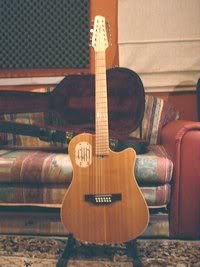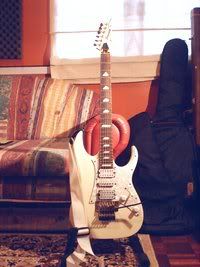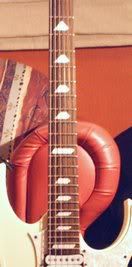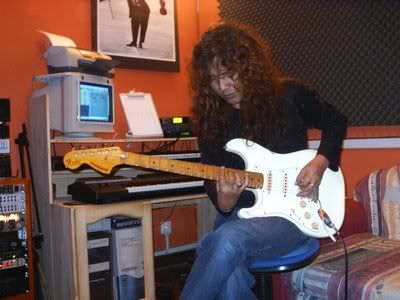(Meet) The Electric family
Since this topic seems to generate some feedback, I would like to see how far the truth is in this hypothesis. Okay, so you have a guitar... all right, maybe two... or perhaps three, counting the one that your brother handed down... now what?
Unless your collection consists of brands like Gibson, Fender or Rickenbecker, chances are, most of your guitars will sound somewhat similar. It is conventional wisdom that Gibson Les Pauls and PRS guitars are in the same tone category. As are Fender and other brands with similar strat designs. I feel that it's a waste to have redundant guitars so as to make all of my axes equally important, here's what I did.

L-R: Yamaha YG512, Fender Strat Standard, Ibanez RG350DX, Washburn KC-40V, ESP M-107
The Yamaha was recently converted into a baritone guitar (tuned to B-E-A-D-F#-B). Since it is a long-scale guitar, I have not detected any noticable problems with the intonation so far. Note that the second string is tuned to F# and not G, this means, you can use standard fingering.
The Fender is tuned to standard 440 with a hybrid gauge (0.95-0.42). Generally used for clean tones and basic crunch riffs.
The Ibanez is also tuned to standard 440 but strung with mediums (0.10-0.45), used for leads and heavy crunch riffs.
The Washburn is strung with mediums but tuned to E flat. This particular axe is a cross between the Fender and Ibanez. It is possible for me to get both types of sound due to the coil-splitter on the tone pot. Having the E flat tuning shaves off retuning time when I'm in the mood for Gn'R and Simple Plan.
The ESP is a seven-string (tuned B-E-A-D-G-B-E). Coupled with the Yamaha, it makes a great combination whenever someone comes along to jam Nu-Metal.
It's great to have several guitars on the rack and unless you are a staunch believer in monogomy (guitar-wise), be fair to your other babies by giving them specific roles... and only then, the 'switching guitars between songs' is justified. Heh heh.
Unless your collection consists of brands like Gibson, Fender or Rickenbecker, chances are, most of your guitars will sound somewhat similar. It is conventional wisdom that Gibson Les Pauls and PRS guitars are in the same tone category. As are Fender and other brands with similar strat designs. I feel that it's a waste to have redundant guitars so as to make all of my axes equally important, here's what I did.

L-R: Yamaha YG512, Fender Strat Standard, Ibanez RG350DX, Washburn KC-40V, ESP M-107
The Yamaha was recently converted into a baritone guitar (tuned to B-E-A-D-F#-B). Since it is a long-scale guitar, I have not detected any noticable problems with the intonation so far. Note that the second string is tuned to F# and not G, this means, you can use standard fingering.
The Fender is tuned to standard 440 with a hybrid gauge (0.95-0.42). Generally used for clean tones and basic crunch riffs.
The Ibanez is also tuned to standard 440 but strung with mediums (0.10-0.45), used for leads and heavy crunch riffs.
The Washburn is strung with mediums but tuned to E flat. This particular axe is a cross between the Fender and Ibanez. It is possible for me to get both types of sound due to the coil-splitter on the tone pot. Having the E flat tuning shaves off retuning time when I'm in the mood for Gn'R and Simple Plan.
The ESP is a seven-string (tuned B-E-A-D-G-B-E). Coupled with the Yamaha, it makes a great combination whenever someone comes along to jam Nu-Metal.
It's great to have several guitars on the rack and unless you are a staunch believer in monogomy (guitar-wise), be fair to your other babies by giving them specific roles... and only then, the 'switching guitars between songs' is justified. Heh heh.
 For the past month I have a new wake-up call: a sledgehammer or a jackhammer. It never fails to provide me with this invaluable service every day (except Sunday) at 8:30am. The problem is, the hammering persists until about 10:00am where they break for coffee and continue till lunch, half an hour later.
For the past month I have a new wake-up call: a sledgehammer or a jackhammer. It never fails to provide me with this invaluable service every day (except Sunday) at 8:30am. The problem is, the hammering persists until about 10:00am where they break for coffee and continue till lunch, half an hour later.

 I was just warming up to 2005 and next thing I know, the first quarter is ending! Did the Asian Tsunami 'quake really sped up the earth's orbit (as a friend of mine claimed)? I mean, time really flies this time around... I've only begun writing demos for this year's share of production and it's already time to fill in the dreaded LHDN form (and is it my imagination or the new shorter forms are more complex???). Heck, I've not even started collecting dues for last year's projects! Dazed, I am... baffled, I must be...
I was just warming up to 2005 and next thing I know, the first quarter is ending! Did the Asian Tsunami 'quake really sped up the earth's orbit (as a friend of mine claimed)? I mean, time really flies this time around... I've only begun writing demos for this year's share of production and it's already time to fill in the dreaded LHDN form (and is it my imagination or the new shorter forms are more complex???). Heck, I've not even started collecting dues for last year's projects! Dazed, I am... baffled, I must be...



